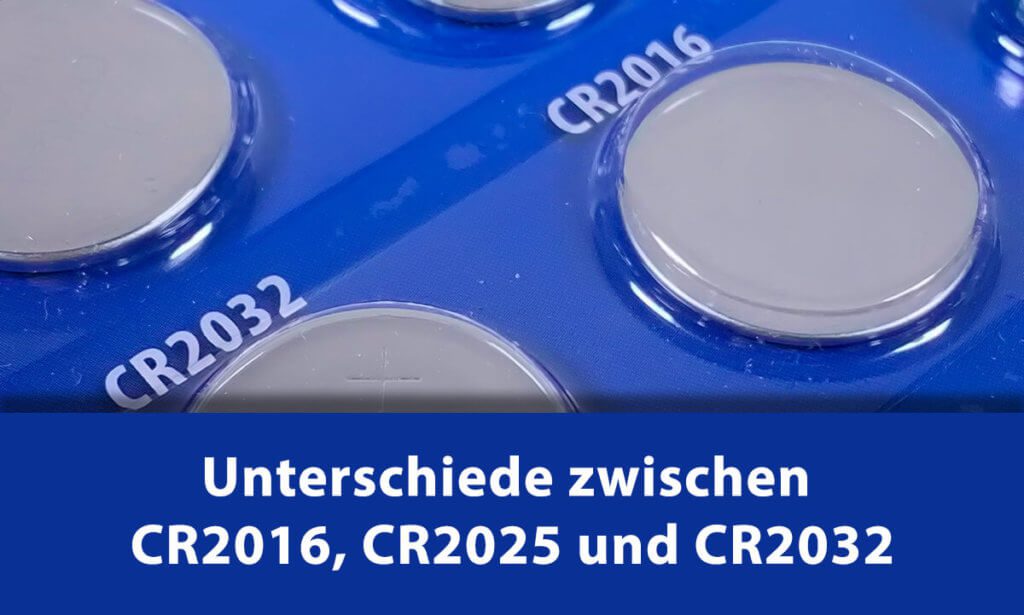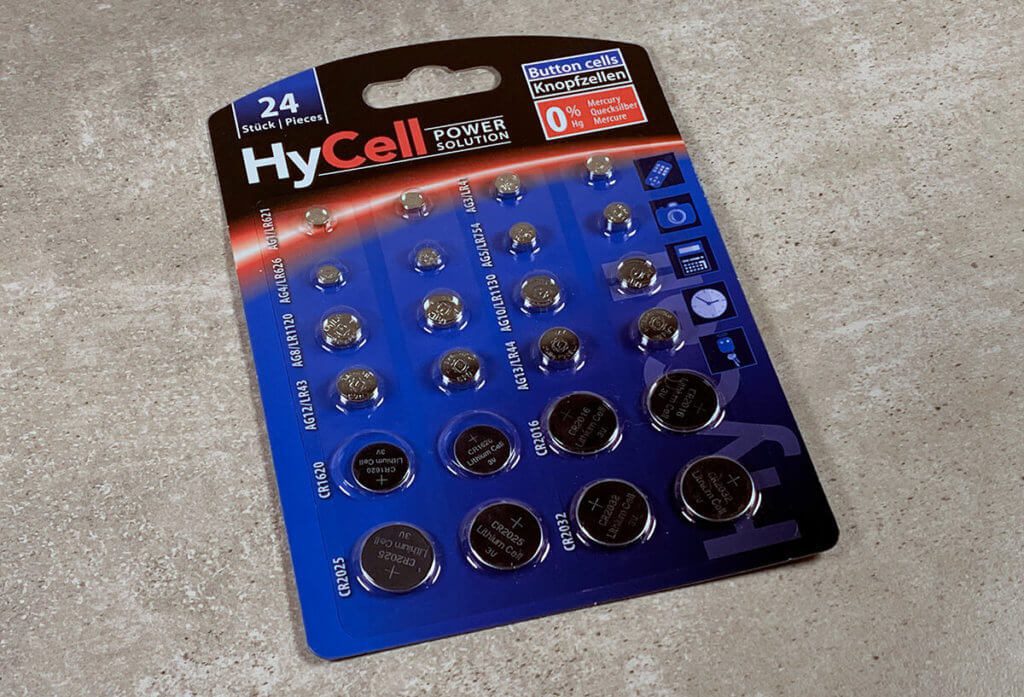The CR series batteries fall under the label of “button cells” because they are round and flat in shape like a button. Since the button cells differ from the CR series with the model designations CR 2032, CR 2023 and CR 2016 are relatively similar, one might get the idea that they can be used equally in devices. Unfortunately, this is not the case, as there are some technical differences in the design.

Chapter in this post:
- 1 Differences in the dimensions of the CR cells
- 2 differences in capacity
- 3 rechargeable? Only the types ML and LIR!
- 4 Update 25.11.2020/XNUMX/XNUMX: Difference between ML and LIR
- 5 2x CR2016 = CR2032? NO!
- 6 The trick with the aluminum ball
- 7 Where can I buy button cells?
- 8 inexpensive button cell sets
- 9 Similar posts
Differences in the dimensions of the CR cells
The first difference between the three button cells is the size. While all three models have the same 20mm diameter, there are differences in the thickness of the CR batteries:
- CR2016 1,6mm
- CR2025 2,5mm
- CR2032 3,2mm
You can tell from the name how it is composed:
- the “C” stands for lithium manganese dioxide cell
- the “R” stands for round cell
- the first two digits stand for the diameter, in this case 20 mm
- the last two digits stand for the thickness: 1,6 mm / 2,5 mm or 3,2 mm

Differences in capacity
There are also differences between the three models of CR button cells in terms of electrical values. While all three have the same voltage of 3,0 volts, they have different capacities due to their different volume:
- CR2016: 75 - 90 mAh
- CR2025: 150 - 165 mAh
- CR2032: 210 - 230 mAh
A higher capacity (larger number when specifying the mAh) means in practice that the button cells can deliver more electrical power. If you were to operate a pocket calculator with a CR2032 instead of a CR2016 button cell, it would last more than twice as long. However, due to the different heights of the design, this will usually not be possible.
- Read more: Buy watch batteries - the most popular models and manufacturers
- Read more: Flameless LED tea lights with timer function for autumn and winter
- Read more: Button cell LR44 - comparison type, data and identical replacement
Rechargeable? Only the types ML and LIR!
Since I was asked if the CR2032 and CR2025/2016 are rechargeable, I did a little research in this direction. The result: The variant with “CR” at the front is always a disposable battery. Only the models with “ML” and “LIR” in front (i.e. ML2032 or LIR2032) are rechargeable batteries. If you try to charge the CR button cells, they can explode in the worst case. Due to the built-in lithium, this is usually associated with flames, which can lead to a fire on flammable surfaces. So before loading, please check the designation of the button cell!
Update 25.11.2020/XNUMX/XNUMX: Difference between ML and LIR
A question that a reader asked me should still be answered: What is the difference between ML2032 and LIR2032 and what do these abbreviations stand for.
- LIR = lithium-ion cell
- ML = lithium manganese cell
The difference between these two types of button cell is not only in the chemical composition, but also in the nominal voltage and the charge:
- LIR: 3,6 V / approx. 40 mAh
- ML: 3 V / approx. 80 mAh
Now which is the better choice? ML or LIR? In most cases, this is probably the ML button cell, as it has a higher energy density than the LIR variant and thus “lasts” longer. However, both types cannot match the runtime of a disposable CR button cell, which can deliver almost three times as much energy as an ML button cell.
2x CR2016 = CR2032? NO!
I was recently asked whether you could use 2032x a CR2 button cell instead of a CR2016. The dimensions are then identical and it would fit into the corresponding device, but you would have connected two 3,0 volt batteries in series, resulting in a total voltage of 6,0 volts. This is twice as high as the voltage that the device actually expects and one can assume that the calculator or the remote control - or whatever device it is - will be permanently damaged. In short: the probability is very high that you will break the device with it. So: 2x CR2016 ≠ CR2032 !!!
The trick with the aluminum ball
Today I got a trick from my reader Helmut on how you can help yourself when a CR2032 is necessary, but you only have a CR2016 or a CR2025 available. It's the same if you need a CR2025 but only have a CR2016 on hand.
The only problem here is the lack of height, which prevents the flatter model from being used. In terms of tension, there would be no problem.
To compensate for the missing height, you can make a small ball out of aluminum foil and insert this into the device with the flatter button cell. It is important, however, that the ball does not slip towards the edge, otherwise there is a risk of a short circuit. And you should always only press the aluminum ball on the top of the button cell, since no contact with the other pole is possible on the top.
The trick is ok if you know what you are doing. I would say: “Use at your own risk!”. A short circuit in a button cell can quickly lead to an explosion of the battery, which should be avoided at all costs. But maybe the trick will help one or the other reader out of an emergency. Thanks for the addition, Helmut!
Where can I buy the button cells?
While button cells of the same type all look the same at first glance, there are different offers in terms of quality. In practice, you quickly find that non-name offers often look like new batteries, but have usually been stored for too long and are therefore no longer completely full. Within a short time the devices are empty again and you have to buy appropriate button cells again.
If you prefer to focus on quality here, you should choose brands such as Duracell or Varta. These usually have a shelf life of up to 10 years and are not empty again shortly after the battery has been changed. I have listed the corresponding offers here:

Cheap button cell sets
Another recommendation is a so-called button cell set, which contains many different types of button cells. Such a set has the great advantage that you don't have to buy each battery individually and that you have the right model in stock for a wide variety of household appliances such as remote controls, car keys, flashlights or mini flashlights. A good set that I also use is this one from HyCell. It also includes the three coin cell models mentioned above:
Related Articles
Jens has been running the blog since 2012. He acts as Sir Apfelot for his readers and helps them with technical problems. In his spare time he rides electric unicycles, takes photos (preferably with the iPhone, of course), climbs around in the Hessian mountains or hikes with the family. His articles deal with Apple products, news from the world of drones or solutions to current bugs.
The page contains affiliate links / images: Amazon.de









Thanks for the informative article. Well explained!
Very informative article! thank you
I always only buy the mixed packs, because I always feel fooled and ripped off with the packs with only one variety.
24 batteries for €6,00 versus just 5 batteries for €3,93
(I tell myself that the mass production of the battery reduces the production price of a single battery to just a few cents)
Hello George! Do you also use up a large part of the mix? Or do you always have certain types left over? 😊
Dear Jens,
this question is redundant! Anyone who reads your blog regularly and follows your purchase incentives has enough devices to be able to use any type of battery.
Or to put it the other way around: If you can't use every type of battery, you have to read somewhere else -> LEGO.DE or PLAYMOBIL.DE or something like that.
Hi Peter! You won! 😂
Thank you very much, very well explained!
The one with the purchase recommendation for the button cell set is anything but a good idea. Guaranteed only 1-2 different cells from this set are ever needed. The rest of them end up in the household waste at some point.
Hello moses! So I've already used at least three different button cells from it: one type for the remote control of the parking heater, one for the kitchen scales and one for a mini flashlight. But if you only have one or two devices that need such button cells, then it is certainly wiser to only buy these batteries specifically.
Sometimes I specifically buy bulk packs of a certain battery size, but I also take these mixed packs with me. However, it is worth taking a look at the mixture contained. If only small thick ones are in there, I can use them least.
But mostly I actually use all the sizes I have bought.
It also depends a lot on how many different devices you have.
Yes, that is right. It would be best to make a list of all devices and battery types that you have at home. Then you would know exactly what you need. But somehow I only look into things when they no longer work. : D
Question: Can I use a 2 in a radio remote control instead of the planned 2016 * 2032 (reverse case than described in the article). At least during the first test it worked, even if only 3V was applied.
Hello Karlheinz! That depends very much on the device. If the remote control can work with 3 volts instead of 6 volts, then it shouldn't be a problem. But other devices just might not work. However, nothing can be broken with the test, because in contrast to a higher operating voltage (than prescribed), a lower voltage cannot destroy anything.
Thank you very much for the great explanation, but everyone should first check the battery in the main board, whether c2032 or c2025
greetings and a happy new year
Dietmar Presser
Thanks for discussing the features and differences. Now I'm much better oriented in the "shortcut technical Spanish".
Hello, if I use 2 times cr 2016 instead of 2 times cr 2032, I would only have increased the capacity and of course the overall height
No, exactly different ... if you take two CR2016, you have double the voltage. This can be detrimental to devices and destroy them, since they expect the lower voltage.
Is correct - if you have 2 CR2016 in series against two CR20302, the capacity and height increase. The voltage remains at 6 V.
Hello Mattes! I think the sentence didn't come across in full. Replacing 2x CR2016 with 2x CR2032 in series increases the capacity and height, but the voltage remains at 6 volts. That is correct of you.
Hello, Thank you for this great article.
It would be interesting to know what is the difference between ML and LIR rechargeable button cells? And which variant would be the better choice?
Then this article would be perfect.
In this ML and LIR are addressed but otherwise not discussed further, which I think is really a shame.
Hello! Thanks for the constructive objection. I will add it in a separate paragraph in a moment. LG
Thanks, a good explanation!
Thank you for the good explanation!
With pleasure! : D
Hallo,
are there different outputs for one and the same battery size?
I need the CR2450 for my car remote control and have already seen it offered with 500mAh and 600mAh.
The one I selected has "Long lasting Power guaranteed" as marketing but there is the same battery without this information...
Hello Christian! Yes, I can already imagine that there are different capacities, although the dimensions of the battery are the same. This is due to the chemical composition with which the battery works. What I would not buy are such flea market packs with button cells, as they have often been lying in the corner somewhere for years. In doing so, they lose quite a bit of capacity. Even if it says "long lasting" it won't last much longer...
@Jens
In your article, as well as here in the comments, you write that you recommend the branded products when choosing between NoName batteries / rechargeable batteries and branded products.
Both at Stiftung Warentest and other (shopping) tests it turned out that the cheaper NoName products were often not worse, sometimes even better, but always cheaper, also in terms of price-performance ratio!
In addition, these NoName goods have the advantage that they are bought much more frequently because of their lower price, so that they do not lie on the shelf for as long, i.e. are not as old as the expensive branded products, which are often much worse due to the long storage time; this was shown by test purchases.
In addition, NoName products are often manufactured by the same companies as the branded products with the same quality. Because then the only difference is the price; at a disadvantage for the brand!
SO a good recommendation would be: no-name products are usually more recommendable: brand means “not necessarily good”, but “always expensive”, often even “worse”!
NoName means “sometimes not good”, but “almost always cheaper”!
Hello Werner! I'm open to critical comments, but it would be nice if you could cite sources for the points. For example: Who made test purchases and what is the result? I don't mean to invalidate your claims, but if I rephrase my articles, I'd like to write why. Also with regard to “cheap batteries are bought more often than expensive branded products” one could argue differently: branded products are bought more often than no-name products because of the illusion of better quality.
And finally, I can refer to a test report by Stiftung Warentest on the subject of hearing aid batteries (test 02/2018). Here Power One was the test winner for some battery sizes and Power One is Varta's "cheap brand" as far as I know. Varta, on the other hand, I would describe as a typical branded product, which I usually recommend.
Of course, you can get just as good quality with non-name products as with branded products. But under certain circumstances you have to accept a setback ... and if you don't like that, in my opinion, you usually drive safer with branded products.
Thanks on my part too! All questions answered in an understandable way!
Very informative and practical article, and also very well put to the point. Thanks very much.
Fine article, very precise, thanks! Just a question about the aluminum ball trick - why not just use a non-conductive material such as kitchen roll? Tear off a small piece and fold it up, then there is no risk of short circuiting...
I assume because aluminum is conductive and you bridge the gap with the aluminum ball. With a non-conductive material, current simply would not flow.